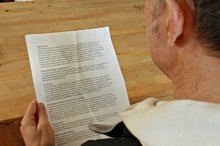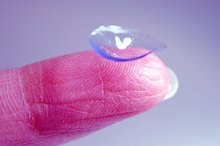Types of Eye Glasses for Someone Nearsighted
Nearsightedness, or myopia is a common vision problem that affects about four out of every 10 people 1. People who are nearsighted have trouble seeing in the distance. Eyeglasses used to correct nearsightedness are either prescribed to be worn occasionally such as driving or watching a movie or prescribed for full-time use when someone has trouble seeing at most distances. Specific eyeglass features work better for different types of nearsightedness.
Frames
Frames come in three basic styles: plastic, metal and rimless. The style that works best depends on the type of prescription. Nearsighted prescriptions are written with a negative number that indicates diopters. The numbers range from -0.25 to -20.00 and higher. The higher the base number, the thicker the edge of the lenses. Mild myopia will have a prescription of -3.00 diopters or less, moderate nearsightedness has a range of -3.00 to -6.00 diopters and a prescription over -6.00 diopters is considered severe.
Plastic eyeglass frames give the most stability and color choice for most heavier prescriptions. This type of frame is good for concealing the heavier or "coke bottle" lenses over -6.00 diopters.
Metal frames can be used for nearsighted eyeglasses, especially if the prescription is mild or moderate. The edge of the lens will be much more visible in prescriptions over -6.00.
Rimless frames have less frame material, and little to no frame around the rim of the lens. The edge of the lens will be more obvious in rimless frames than in metal or plastic.
- Frames come in three basic styles: plastic, metal and rimless.
- This type of frame is good for concealing the heavier or "coke bottle" lenses over -6.00 diopters.
Lens Choices
What Do Prescription Numbers Mean in Eye Glasses?
Learn More
According to the Cleveland Clinic, eyeglass lenses used to be made exclusively out of glass but today most lenses are made from different types of plastic, especially for nearsighted lenses 4. Plastic lenses are lighter and more shatter-resistant. There are different styles of plastic, including polycarbonate, hi-index, aspheric and photochromic.
Polycarbonate lenses are the most shatter resistant and are a good choice for nearsighted people who participate in sports and for children. High-index plastic lenses are lighter and thinner than the standard plastic lenses but cost more.
Aspheric lenses are specialty lenses that are designed with special curves which allows the lens to be thinner and flatter than other lenses and gives crisper vision than the standard lens.
Photochromic lenses are made from glass or plastic and get lighter indoors and darker outdoors.
- According to the Cleveland Clinic, eyeglass lenses used to be made exclusively out of glass but today most lenses are made from different types of plastic, especially for nearsighted lenses 4.
- Aspheric lenses are specialty lenses that are designed with special curves which allows the lens to be thinner and flatter than other lenses and gives crisper vision than the standard lens.
Reading Glasses and Bifocals
People who are nearsighted and also need reading glasses are called presbyopic. Presbyopia affects almost everyone over the age of 50, according to the Ohio State University Medical Center 2.
Bifocal lenses are available with and without lines. Reading glasses are an option for nearsighted people who are presbyopic and wear contact lenses for distance.
Eyeglasses can be made so that the entire lens is the reading prescription to be worn over contact lenses or as a bifocal lens with clear lenses at the top and the reading prescription in the bottom portion of the lens.
Wearing a full reading lens gives a much bigger viewing area and is a good choice for someone who does a lot of detail work but the lenses must be removed to see in the distance with their contact lenses.
Bifocal lenses work well for nearsighted people who wear contacts but need to see in the distance and read occasionally. Bifocals lenses that are worn over contact lenses can also be made with or without lines.
- People who are nearsighted and also need reading glasses are called presbyopic.
- Bifocal lenses work well for nearsighted people who wear contacts but need to see in the distance and read occasionally.
Related Articles
References
- All About Vision: Myopia
- The Ohio State University Medical Center: Refractive Errors
- Archives of Ophthalmology: Increased Prevalence of Myopia in the United States Between 1971-1972 and 1999-2004
- Cleveland Clinic: Eyeglasses
- DocShop: Myopia Information
- Roberts JE. Ultraviolet radiation as a risk factor for cataract and macular degeneration. Eye Contact Lens. 2011;37(4):246-9. doi:10.1097/ICL.0b013e31821cbcc9
Resources
Writer Bio
Beth Richards, a freelance writer since 2002, writes about health and draws from her 25 years as a licensed dispensing optician. She has authored several books, writes for national magazines including "Country Living" and "Organic Family" and is a health and wellness features writer for several publications. She is earning a Bachelor of Arts in English from the University of Maryland.








